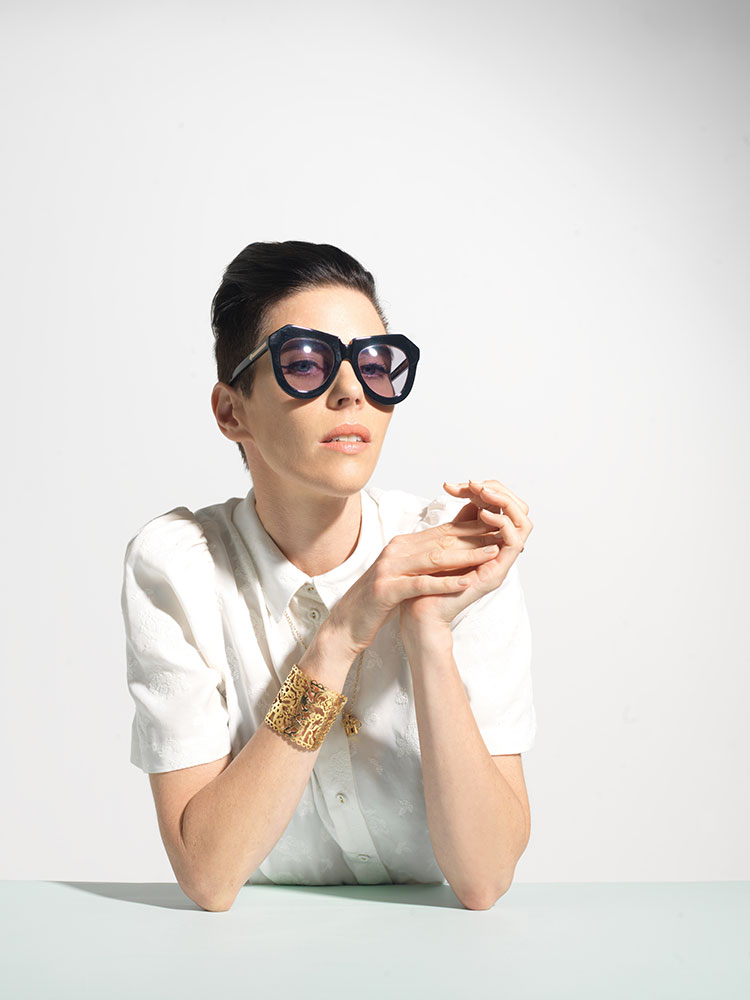
She’s one of our coolest and most successful exports, but Karen Walker isn’t one to rest on her (no doubt very stylish) laurels. Fiona Hawtin sits down with the legendary Kiwi designer as she prepares to conquer yet another fashion hurdle – this time in her own backyard.
For someone with a to-do list that would strike fear into the hearts of most, Karen Walker looks as cool as the proverbial cucumber. She’s seated at a table in the showroom at her Auckland headquarters, her MacBook and trademark oversized glasses within easy reach. So obsessed with the shades from last season is she that “there’s something wrong if I haven’t got them on”. She’s at ease in her current season Karen Walker blue shirt teamed with Levi’s, Clergerie raffia flatforms, cool androgynous short hair and intensely blue eyes. There’s minimal jewellery – just a ring – and almost no makeup over those to-die-for cheekbones. She is the epitome of unstudied, easy elegance. Never mind the fact she’s flying to New York in a week to show ‘Time Machine’, her northern hemisphere winter 2015 collection at New York Fashion Week. It’s a tribute to Walker’s awe and remembrance of time traveller Joanna Lumley in 70s television sci-fi series Sapphire & Steel, in which the heroine managed to look so chic while keeping the integrity of time intact.
“Functionality and strong does not exclude glam,” explains Walker, as she prepares to send models down the runway in utilitarian denim, sheepskin coating, chunky knitwear and time travel-ready rubber tread shoes. She’s also preparing to open UK mega-brand Topshop in New Zealand with the Auckland flagship store, of which she and husband Mikhail Gherman are business partners. Oh, and the not-so-small launch of her top secret beauty line into New Zealand, Australia and UK, which has been two years in the making.
Still, the chief designer and CEO of Karen Walker is unflappable – her only slight concern is the possibility of rain, because she and Gherman are planning an outing later that day. They’re taking the ferry to the art walk on Waiheke Island. Never mind, she says. They have those Blunt umbrellas. What, no Karen Walker brollies? “That’s May,” she states. Always thinking ahead. This is in addition to the Karen Walker Paints, with Resene treating wall paint the way she does fashion by presenting a tight edit of colours; her Karen Walker eyewear; Karen Walker jewellery; Hi There diffusion range stocked by American chain Anthropologie and Myer in Australia. There are also shoes; bags; homewares and the highly-driven designer is also part of the group behind The Department Store, modern version of yes, a department store, on Auckland’s North Shore. Are you keeping up? The potted history goes like this: Walker was at fashion design school but left with a couple of garments to set up her own company after making a shirt for a friend in 1988. She married Gherman when she was just 21 in a dress her grandmother thought too short for decency and, while he worked in creative for advertising agencies, he also became the creative director at Karen Walker.
She is the country’s most globally recognised designer, with 950 stockists across 30 countries, and has shown at New York Fashion Week for nine years; flew 250,000km last year and is likely to do the same in 2015; was on the front page of the New York Times the first season she showed and has made The Business of Fashion top 500 list as one of the most influential designers in the world for the past two years running. Phew. Today Gherman, 51, sits across the table from Walker. In between bursts dashing off to do some filming for social media, he is riffing on the future of fashion for their brand. An interview with 45-year-old Walker is pretty much a tag-team effort, with both contributing to the conversation. Both are extremely articulate, although Gherman is more stream of consciousness, while Walker gets straight to the point. “It’s such a changing landscape, the paradigm has shifted so many times in the period we’ve been in fashion. Who knows what’s a year ahead, or five, or 10. I’m not going to claim I have a crystal ball in that regard. It’s about having a unique voice at any time in fashion. Brands that have done well are the ones where you can cover the logo and still know who it is,” says Walker.
Her trademark is optimistic, unpretentious fashion which throws opposites together such as masculine and feminine, luxury and practical, street and utility. “That thing there is the message,” says Gherman, pointing to the arrow on his glasses, which was devised in 2002 and is now synonymous with Karen Walker in the same way the intertwined Cs are with Chanel. “It was a way of saying an adventurous spirit. They [along with the Runaway Girl] were fortuitous symbols of our intent for moving forward and exploring things,” he continues. “It’s a visual representation of the way Karen is as a person.”
He believes a good part of the success of their empire is down to his wife’s ability to see projects through. This is across all aspects of her life. Take for instance, the 500-piece “Jeeves and Wooster-esque” garden party puzzle Walker’s Scottish-based psychiatrist brother sent their seven-year-old daughter Valentina for her birthday. No one sleeps, jokes Gherman, when there’s a puzzle on the go in the Ponsonby house. “I said, ‘shall we do it now, Valentina?’ and she was like ‘no, I want to play with something else’. The next day I said, ‘it’s a cloudy day, shall we start it?’ I was just dying to get into it,” says Walker, confessing she got up early the next day to finish it. “Valentina can do a 300-piece puzzle in 10 minutes. She’s kind of awesome because I look at it and I just see bits, but Karen and her can see shapes and order in those shapes,” says Gherman. Once Walker “gets her mind set on something”, Gherman says, it will happen. “She hates people who change their mind. We had this discussion the other day about ‘shall we serve salad or not with the pizza?’ I said, ‘let’s not do it because I don’t want to be doing the dishes,’ and then she said ‘fine’ and starts putting everything away, and I was like ‘actually no, we should’. ‘Too late.’ And then we negotiate for two hours,” laughs Gherman. They did end up with salad but it was a hard-fought battle. “That’s the yin and yang of our relationship, why it works,” says Walker. “I can make order out of chaos and he can make chaos out of order.” But before chaos must come the original idea, without which they wouldn’t have a business.
“You always need the people who sit down and they’ve got a white piece of paper and a black pen,” says Walker. She’s not remotely threatened by prophecies of 3D printers revolutionising every part of our lives and the customer being able to get a dress off the printer, because her job is the idea. “There isn’t yet an app that comes up with new ideas. When that computer programme is created, I’ll be the first one lining up to buy it, trust me. You always need the ones who come up with the idea out of nothing.” That desire to create something new is their driving force. “It gives the energy back, the creativity. It’s seeing something working and that just charges your batteries,” says Walker.
“Coming up with new ideas out of nothing is the most challenging but it’s also the most fun. It’s the thing that gets us out of bed but also the thing that drives us a little bit crazy some days. Even on good days it’s not the easiest thing in the world to go ‘what’s next, what’s next?’” They talk a lot about zigzagging. “Shifts in fashion aren’t just due to designers zigzagging and pushing against what has been popular in the past. Good designers respond to technical advances, sociological changes, shifts in moral attitude and environmental impact. Any big shift in fashion throughout any period can be linked back to one of these triggers,” explains Walker on how fashion evolves. “There are a million examples of this. For instance, the French Revolution led to what is now the classic men’s tailored suit. The dominance of mid-20th century American culture is responsible for the denim and T-shirt uniform that’s still relevant today. Trousers on women came out of women’s emancipation. The current sport-luxe phenomenon is triggered by the western world’s health obsession. I could go on and on. “There are an infinite number of things that will affect fashion in the future. There’ll be a certain amount of fashion created out of reaction to what has been and a lot out of technical advances, societal shifts, changes in attitude and the environment. In the future, convenience, versatility and multi-functionality will all become more and more important in fashion.”
Walker also believes buying will be more “multi-faceted” in the future. But even with new technology, the zigzag theory remains. Every season is a reaction to the season before. “It’s about reacting to what you’ve already done and what the market’s already seeing. When we came into the eyewear business, we were reacting to the eyewear that was already out there that was a bit timid and a bit small and generic. We went, ‘well, what’s the opposite?’ The same with the fine jewellery business. It’s about creating something different to what has been and most of it’s just intuitive. You’ve got to trust your instincts. Good design never comes out of committees. It comes from one, two or three people,” says Walker. Subverting the classics, Gherman calls it. And there’s no doubt that reinterpreting eyewear has been lucrative for the brand. The eyewear line has just celebrated 10 years. Last year sales were $30-$35 million retail worldwide, with 100,000 pairs sold and the likes of celebrities Lena Dunham, Beyoncé, Rihanna, Scarlett Johansson and Florence Welch wearing them. Walker can pinpoint exactly the moment the desire to be truly global hit her.
She was visiting a multi-brand boutique in Paris 20 years ago and wondered why she couldn’t have her clothing in there. “It was intrinsic to us that at a certain point we’d have to go outside of New Zealand. If you want to be niche, you have to be global. To get the business past any size in New Zealand – if you’re New Zealand-focused – you have to be more mass market,” says Walker. Being a global business based in New Zealand is a “nightmare logistically”. It’s her home and she loves it, doesn’t want to live anywhere else, “although I’d like a month in the South of France once a year”, but in terms of the label she could live anywhere. To paraphrase her friend, UK-based fashion writer Marion Hume, “no woman in the world ever wakes up and says, ‘Today I’m going to wear a New Zealand designer’, or ‘today I’m going to wear a French designer’. They go, ‘today I’m going to wear my Prada pants, my Karen Walker shirt and my Topshop shoes’.” Regardless of being global, Karen Walker is still an indie brand, as opposed to a mega brand like Topshop or Prada, and she believes there will always be room for the likes of such brands “as long as your ideas are good. Ideas are what it all comes down to.”
Ideas and vision and audacity and energy. Gherman points out that successful young New Zealand brand I Love Ugly, with stores in Los Angeles and Melbourne, isn’t limited “because they come from the new world, where there are no gatekeepers, in the same way Lorde has done well. The barriers are gone and people are actually wanting personal experiences, so big brands are trying to appear more indie. They have this new formula – their channels of communication are through social media. Indie’s become really important as people are looking for more personal life experiences.” Another way they future-proofed the business was to branch out into different products through licences. Years ago, they drew up a list of 10 categories where they thought they would have a unique point of view. Eyewear, paint, beauty – “everybody’s come to us, which has been really nice, but we’ve turned down a lot of opportunities also,” says Walker.
They need to be able to say something unique about the potential new product, but they also ask themselves, does it feel authentic and would they want to take the people they would be working with out to dinner? If the answer’s yes to all that, they take the next step. It helps that Walker has a natural talent for business. She’s never read a management book in her life but is keen to read Steve Jobs’ biography, because he’s her only real business hero. “He created a brand built around amazing products and ideas nobody else had thought of, not just doing the same with a little twist. I was sad when he died. I don’t think he would have done a focus group.” Nor has she. She’s pretty confident Topshop will be well received here without any formal research into the matter. She has been dabbling in the British giant’s ranges for the past four or so years, after they approached her to stock it in her own retail spaces, and has now facilitated the first full- blown store in the country. It’s a serious commitment they and business partner Barkers are undertaking, with a 1000sqm inner-city site. “The definition of a city 500 years ago was something with a cathedral. I think now it’s something with a Topshop and a Prada,” laughs Walker.
It really is next level to anything they’ve done before. They even have an in-store escalator; their first one. Both are rather taken with it. So much so Gherman scrolls the photos on his phone and brings up a picture of it about to be installed. Still, as a director and shareholder of Topshop, the opening isn’t keeping her awake at night with fear. “Every box that needs to be ticked is ticked.” Walker looks out to check the weather. If only she could tick clear sky off the list. “What’s happening tonight?” asks Gherman, clearly forgetting the outing. “We’re going to Waiheke. It’s in the diary.”
From the editors of NEXT










